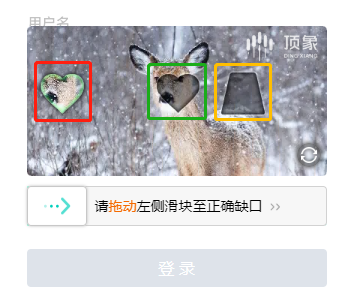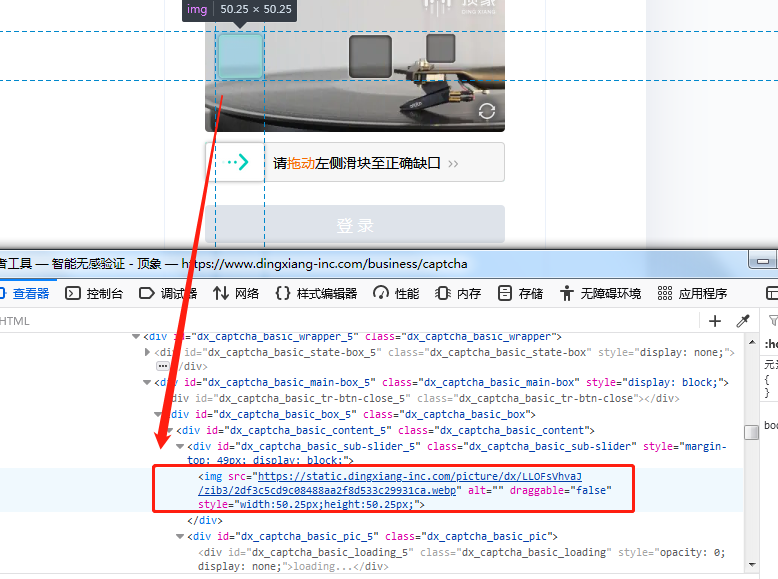前言
本文详细介绍了破解顶象滑动验证码的所有过程,包括破解思路,实现步骤还有测试结果,相信你看完之后也能轻松破解滑动验证码;
另外,其他类似验证码的破解步骤请参考:
《腾讯防水墙滑动拼图验证码》
一丶解析验证码组成

从上面三张图来看,顶象滑动拼图验证码是由一个小的拼图和一个大的背景图组成,拼图的形状各式各样,背景图中有两个阴影缺口:一个跟拼图一样的阴影缺口,还有一个形状不确定大小也不确定的阴影缺口。

二丶分析出破解思路
- 首先根据这个验证码的组成,来分析一下我们人要做的事情:
按照正常的手动操作流程来看,我们需要看出背景图中与拼图对应的阴影缺口的位置,然后鼠标按住下方滑块来把拼图对正到缺口位置来完成验证。
- 然后根据人要做的事情,来分析一下程序要做的事情:
根据分析得出下面几个步骤:
1.获取到两张图片(背景图、拼图)
2.处理图片,得到阴影位置并计算滑动距离
3.根据滑动距离模拟滑动
三丶具体操作步骤
1丶查看网页源码并提取图片信息


从上图可以看到,拼图的网络地址存在<img>标签内,而背景图是以canves画布的形式展现出来的。
拼图我们可以通过selenium获取到img标签中的网络地址,再通过请求获取到图片信息 。
背景图可以参考《如何抓取canvas画布中的图片》来获取图片信息。
2丶处理图片,计算滑动距离
这里由于拼图的图片格式是webp不好处理,所以我们先将拼图转为png格式。
需要导入jar包webp-imageio-core-0.1.0.jar
String sUrl = driver.findElement(By.className("dx_captcha_basic_sub-slider")).findElement(By.tagName("img")).getAttribute("src");
File f = new File("d://dximg.webp");
FileUtils.copyURLToFile(new URL(sUrl), f);
ImageReader reader = ImageIO.getImageReadersByMIMEType("image/webp").next();
WebPReadParam readParam = new WebPReadParam();
readParam.setBypassFiltering(true);
reader.setInput(new FileImageInputStream(f));
BufferedImage image = reader.read(0, readParam);
ImageIO.write(image, "png", new File("d://dximg.png"));
接下来是图片处理过程
1.根据拼图在页面的高度位置将背景图裁剪,缩小匹配范围
// 大图裁剪
BufferedImage sBI = ImageIO.read(sFile);
BufferedImage bgBI = ImageIO.read(bFile);
bgBI = bgBI.getSubimage(0, top, bgBI.getWidth(), sBI.getHeight());
ImageIO.write(bgBI, "png", bFile);

2.将拼图透明部分变为白色
setWhite(sBI);
ImageIO.write(sBI, "png", sFile);
/**
* 透明区域变白
*
* @param image
* @param param
* @throws IOException
*/
public void setWhite(BufferedImage image) throws IOException {
if (image == null) {
return;
} else {
int rgb;
for (int i = 0; i < image.getWidth(); i++) {
for (int j = 0; j < image.getHeight(); j++) {
rgb = image.getRGB(i, j);
int A = (rgb & 0xFF000000) >>> 24;
if (A < 100) {
image.setRGB(i, j, new Color(255, 255, 255).getRGB());
}
}
}
}
}

3.将两张图分别转灰度图像再进行自适应阈值化
Mat s_mat = Imgcodecs.imread(sFile.getPath());
Mat b_mat = Imgcodecs.imread(bFile.getPath());
// 转灰度图像
Mat s_newMat = new Mat();
Mat b_newMat = new Mat();
Imgproc.cvtColor(s_mat, s_newMat, Imgproc.COLOR_BGR2GRAY);
Imgproc.cvtColor(b_mat, b_newMat, Imgproc.COLOR_BGR2GRAY);
Imgcodecs.imwrite(sFile.getPath(), s_newMat);
Imgcodecs.imwrite(bFile.getPath(), b_newMat);
// 自适应阈值化
Mat s_nMat = new Mat();
Imgproc.adaptiveThreshold(s_newMat, s_nMat, 255, Imgproc.ADAPTIVE_THRESH_MEAN_C, Imgproc.THRESH_BINARY, 7, -4);
Imgcodecs.imwrite(sFile.getPath(), s_nMat);
Mat b_nMat = new Mat();
Imgproc.adaptiveThreshold(b_newMat, b_nMat, 255, Imgproc.ADAPTIVE_THRESH_MEAN_C, Imgproc.THRESH_BINARY, 7, -4);
Imgcodecs.imwrite(bFile.getPath(), b_nMat);
b_mat = Imgcodecs.imread(bFile.getPath());
s_mat = Imgcodecs.imread(sFile.getPath());


4.将处理过后的两张图进行模糊匹配
int result_rows = b_mat.rows() - s_mat.rows() + 1;
int result_cols = b_mat.cols() - s_mat.cols() + 1;
Mat g_result = new Mat(result_rows, result_cols, CvType.CV_32FC1);
Imgproc.matchTemplate(b_mat, s_mat, g_result, Imgproc.TM_CCOEFF); // 相关系数匹配法
Core.normalize(g_result, g_result, 0, 1, Core.NORM_MINMAX, -1, new Mat());
Point matchLocation = new Point();
MinMaxLocResult mmlr = Core.minMaxLoc(g_result);
matchLocation = mmlr.maxLoc; // 此处使用maxLoc还是minLoc取决于使用的匹配算法
Imgproc.rectangle(b_mat, matchLocation, new Point(matchLocation.x + s_mat.cols(), matchLocation.y + s_mat.rows()), new Scalar(0, 255, 0, 0));
Imgcodecs.imwrite("d:/dx.png", b_mat);

5.根据图片再页面显示比例计算出需要滑动的距离
(matchLocation.x + s_mat.cols() - sBI.getWidth()) * 3 / 4 - 8)
3丶根据滑动距离模拟滑动
得到滑动距离直接控制滑块滑动就可以了。
滑动代码如下:
/**
* 模拟人工移动
*
* @param driver
* @param element页面滑块
* @param distance需要移动距离
* @throws InterruptedException
*/
public static void move(WebDriver driver, WebElement element, int distance) throws InterruptedException {
int randomTime = 0;
if (distance > 90) {
randomTime = 250;
} else if (distance > 80 && distance <= 90) {
randomTime = 150;
}
List<Integer> track = getMoveTrack(distance - 2);
int moveY = 1;
try {
Actions actions = new Actions(driver);
actions.clickAndHold(element).perform();
Thread.sleep(200);
for (int i = 0; i < track.size(); i++) {
actions.moveByOffset(track.get(i), moveY).perform();
Thread.sleep(new Random().nextInt(300) + randomTime);
}
Thread.sleep(200);
actions.release(element).perform();
} catch (Exception e) {
e.printStackTrace();
}
}
/**
* 根据距离获取滑动轨迹
*
* @param distance需要移动的距离
* @return
*/
public static List<Integer> getMoveTrack(int distance) {
List<Integer> track = new ArrayList<>();// 移动轨迹
Random random = new Random();
int current = 0;// 已经移动的距离
int mid = (int) distance * 4 / 5;// 减速阈值
int a = 0;
int move = 0;// 每次循环移动的距离
while (true) {
a = random.nextInt(10);
if (current <= mid) {
move += a;// 不断加速
} else {
move -= a;
}
if ((current + move) < distance) {
track.add(move);
} else